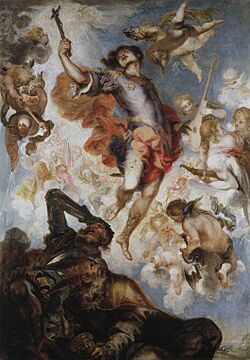Hermenegild facts for kids
Quick facts for kids Saint Hermenegild |
|
|---|---|

El Triunfo de San Hermenegildo by Francisco Herrera the Younger (1654)
|
|
| Martyr | |
| Born | Toletum, Visigothic Kingdom |
| Died | c. 13 April 585 Hispalis, Hispania |
| Venerated in | Catholic Church Eastern Orthodox Church |
| Feast | April 13 |
| Attributes | axe, crown, sword, and cross |
| Patronage | Seville, Spain |
Saint Hermenegild (also spelled Ermengild) was a prince of the Visigothic Kingdom who lived in the 6th century. He was the son of King Liuvigild, who ruled parts of what is now Spain and southern France.
Hermenegild is remembered for converting from Arianism (a type of Christianity) to Chalcedonian Christianity (what we now call Catholicism). This happened during a time when he was in conflict with his father. He died in 585, and his death was later seen as a martyrdom, meaning he died for his faith.
Contents
Who Was Hermenegild?
Hermenegild was the older son of King Liuvigild and his first wife. He grew up following the Arian Christian faith, which was different from the Catholic faith. His father, King Liuvigild, made both Hermenegild and his younger brother, Reccared I, co-rulers. This meant they helped their father govern the kingdom.
Hermenegild's Marriage and Conversion
In 579, Hermenegild married a princess named Ingund. She was the daughter of the Frankish King Sigebert I and was a Catholic. Ingund's step-grandmother, Goiswintha, tried to make her change her faith, but Ingund refused to give up her beliefs.
King Liuvigild sent Hermenegild to govern the southern part of the kingdom. There, Hermenegild met Leander of Seville, an important Catholic bishop. Leander influenced Hermenegild, and he decided to convert to Catholicism. His family wanted him to return to Arianism, but he stood firm in his new faith.
Rebellion Against His Father
Around the time of his conversion, Hermenegild started a rebellion against his father, King Liuvigild. While some people thought it was about religion, others believed it was more about politics and power.
Hermenegild asked the Byzantine Empire for help, but they were busy defending their own lands. For a while, he had the support of the Suebi, another group that King Liuvigild had defeated earlier. However, King Liuvigild managed to defeat the Suebi again in 583.
Hermenegild eventually fled to the city of Seville. When Seville was surrounded and captured in 584, he moved to Córdoba. The Byzantines, who had been helping Hermenegild, left after King Liuvigild paid them a large sum of gold. They took Ingund and her son with them.
Hermenegild sought safety in a church. King Liuvigild respected the church's protection and sent Hermenegild's brother, Reccared, to talk to him. They agreed to a temporary peace.
Imprisonment and Death
Unfortunately, the peace did not last long. Hermenegild's step-grandmother, Goiswintha, caused more trouble within the family. Hermenegild was arrested and put in prison in either Tarragona or Toledo.
While he was imprisoned in Seville, an Arian bishop was sent to him during Easter. The bishop wanted Hermenegild to take communion, but Hermenegild refused because he was now Catholic. King Liuvigild was very angry about this. He ordered Hermenegild to be executed, and Hermenegild was killed on April 13, 585.
Hermenegild had one son with Ingund, named Athanagild. After Hermenegild's death, Ingund and Athanagild tried to find safety in Constantinople, but they were not allowed to enter. Ingund then returned to the Frankish Kingdom, where her son stayed with her and her mother.
Hermenegild's Legacy
At the time of his death, some historians did not mention Hermenegild's conversion or see him as a martyr. For example, John of Biclaro and Isidore of Seville only wrote about his rebellion. The French historian Gregory of Tours did mention Hermenegild's conversion as the reason for his rebellion, but he still saw Hermenegild as a traitor for fighting his father.
However, it was Pope Gregory I who first called Hermenegild a martyr. In his writings, Pope Gregory said that Hermenegild was killed because he refused to take communion from an Arian bishop. Pope Gregory believed that Hermenegild's death inspired his brother Reccared to convert to Catholicism. This conversion then led to the entire Visigothic kingdom becoming Catholic. Pope Gregory's view greatly shaped how Hermenegild was remembered.
As a Catholic martyr, Hermenegild became very important in Spain after the Reconquista, a long period when Christian kingdoms took back land from Muslim rulers. In 1585, Pope Sixtus V officially allowed people in Spain to honor Hermenegild as a saint. Later, Pope Urban VIII extended this recognition to the entire Catholic Church.
Saint Hermenegild has been celebrated in many forms of art, including poems, paintings, and plays. For example, there is a play called El mártir del sacramento, San Hermenegildo written in the 1680s. A famous painting, The Triumph of St. Hermenegild by Francisco de Herrera the Younger, shows him as a victorious saint.
In art, Saint Hermenegild is often shown with an ax, a crown, a sword, and a cross. The Catholic Church celebrates his feast day on April 13. He is also the patron saint of a group of veterans in Spain called the "Royal Brotherhood of Veterans of the Armed Forces and the Civil Guard." The Royal and Military Order of Saint Hermenegild, a Spanish military award created in 1814, is also named in his honor.
See also
 In Spanish: Hermenegildo para niños
In Spanish: Hermenegildo para niños
- Saint Hermenegild, patron saint archive
Images for kids
-
The Baptism of Saint Hermenegild, attributed to Guercino, 17th century


